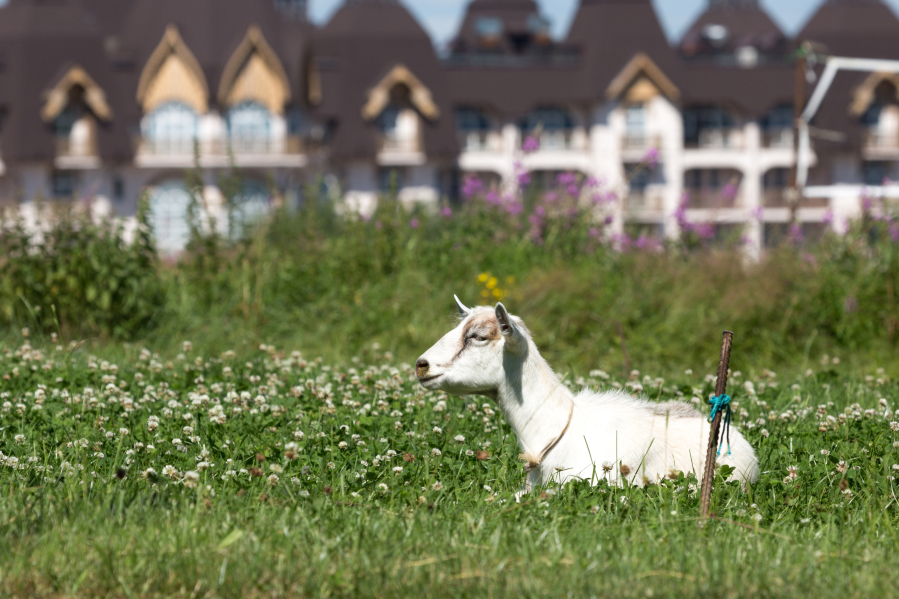SPOKANE — Goats have a reputation for eating everything. That can be a good thing.
On a 60-foot-wide stretch of land following Latah Creek at the southeast corner of Spokane County, a herd of 250 Boer goats are munching away at overgrown meadow grasses.
They are clearing the way for workers from Spokane Conservation District to plant pine trees and native shrubs.
It’s part of a project with the Washington Department of Ecology to restore land along the creek that has long been overused by agriculture.
The program pays farmers $300 an acre for a 15-year contract to use cropland in riparian zones.
Rebuilding the habitat will help improve the water quality by stabilizing the bank and preventing soil erosion, said Walt Edelen, water resources program manager for the conservation district.
The creek, which flows northwest until it pours into the Spokane River downstream from Spokane Falls, is full of sediment and listed by Ecology as one of the most polluted water bodies in the state.
Goats are much easier than mowing the brush and better than chemical herbicides.
“This was a more natural, holistic way to clear the vegetation,” Edelen said.
This is just one of many land management projects handled by Leshay Goat Rentals, owned by Les and Shalene Camp.
Goats are growing more popular as a way to handle all kinds of problems.
Liberty Lake owns a handful of goats to control weeds in the city’s parks.
As wildfire risks increase, some property owners are looking to goats as a preventative tool.
Goats can help reduce fuel by eating vegetation and small saplings. They can trim low tree branches by standing on their hind legs.
The livestock are ideal for small areas where a prescribed burn is not practical or safe. They can be used to clear a defensive buffer around a building.
“Goats are extremely efficient,” Shalene Camp said.
They eat for 16 hours a day.
But goats are not a perfect solution.
“They can only eat so much” said Craig Madsen, owner of Healing Hooves, a goat vegetation management company based in Lincoln County that does brush-thinning projects at parks in Spokane.
Denser areas with larger saplings might need to be cleared mechanically, so goats should be considered in combination with other tools, Madsen said.
Goats can also be used to help manage regrowth after thinning, prescribed burns or wildfires.
The town of Malden, which was devastated by a wildfire in 2020, has since used Leshay’s goats to control brush in town.
“I don’t consider us a fire crew or weed management. We’re land management,” Les Camp said. “We use goats to improve the land and reduce the need for chemicals.”
The type of management depends on the client’s goals.
The Phoenix Conservancy in Pullman uses the goats to clear invasive and noxious weeds in Conservation Park as part of an ongoing project to restore native Palouse Prairie habitat. Since industrial agriculture triggered plowing the region in the late 1800s, less than 1% of the habitat remains.
“The goats do a wonderful job of drawing attention to this park, which a lot of Pullman residents don’t know is here,” said Chris Duke, executive director of the conservancy.
As browsers, goats eat a wide variety of vegetation.
They are great for the environment because they eat just enough and move on without over-grazing the land.
Their high metabolism means they need a lot of protein, so they eat the seeds of a plant first. An enzyme in their rumen sterilizes the seeds, so the plants don’t regrow after they poop out the seeds.
This process produces natural fertilizer, and the goats aerate the soil with their hooves.
Goatherders must be careful, though. Some weeds like hemlock are poisonous, even to goats.
The Camps use a rotational grazing system where they pin the goats into an area as small as a quarter of an acre and keep them there until they have finished grazing before moving to the next section.
“It forces them to eat everything because they’re just like little kids, they will eat the candy and leave the Brussels sprouts,” Les Camp said.
The goats need a lot of attention, so Les and Shalene camp are out with them around the clock when on a job. The fences can get knocked down and the goats can escape. Guard dogs also help defend against coyotes.
Mid-May to July is the heavy growing season when they are busiest.
Madsen said people get curious when they see goats working on a project. The goats are contained in an electric fence, and it’s not a petting zoo.
“It’s fine to watch them,” he said. “Just don’t feed them.”



